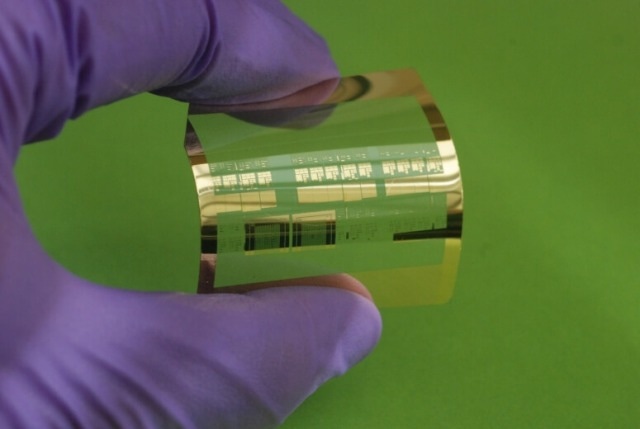Apr 22 2016
A tiny knife is considered the secret behind developing the fastest silicon-based flexible transistors in the world.
 Using a unique method they developed, a team of UW–Madison engineers has fabricated the world’s fastest silicon-based flexible transistors, shown here on a plastic substrate. COURTESY OF JUNG-HUN SEO
Using a unique method they developed, a team of UW–Madison engineers has fabricated the world’s fastest silicon-based flexible transistors, shown here on a plastic substrate. COURTESY OF JUNG-HUN SEO
University of Wisconsin—Madison engineers, collaborated with colleagues from all over the country, and invented a novel method that could help manufacturers effortlessly create cost-effective high-performance transistors with wireless capabilities on large rolls of flexible plastic.
The research team, headed by Zhenqiang (Jack) Ma, the Lynn H. Matthias Professor in Engineering and Vilas Distinguished Achievement Professor in electrical and computer engineering, and research scientist Jung-Hun Seo, designed a transistor that works at a record 38 gigahertz, even though their simulations highlight that the transistor is also capable of working at an overwhelming record of 110 gigahertz. In computing, this represents lightning-fast processor speed limits.
The transistor is also extremely useful in wireless applications, and can transfer power or transmit data wirelessly. This feature has potential for a wide rage of enhanced applications, from wearable electronics to sensors.
A report on this research has been published in the April 20th issue of Scientific Reports.
The team’s nanoscale fabrication method alters the standard lithographic approaches, which use chemicals and light to design flexible transistors, overcoming barriers like imprecision leading to short circuits of varied contacts, light diffraction, and the need to fabricate the circuitry in several passes.
Ma, Seo and their team used low-temperature processes to design the circuitry on the flexible transistor, using a cost-effective and simple process known as nanoimprint lithography. These low-temperature processes refer to the placing of single-crystalline silicon on a polyethylene terephthalate (PET).
In the selective doping method, the researchers added impurities into materials in specific locations in order to improve their electrical conductivity. Sometimes, the short channel effect occurs when the dopant enters into specific areas of the material it is not supposed to access. However, an unconventional approach was taken up by the researchers. They covered the single crystalline silicon, using a dopant instead of selectively doping it.
The researchers then added a photoresist layer, or a light-sensitive material, and executed the electron-beam lithography method, which forms shapes that are 10 nanometers wide. The electron-beam lithography method was applied on a focused beam of electrons to form a reusable mold of the nanoscale patterns they wanted. This mold was then used on an extremely flexible, ultrathin silicon membrane to develop a photoresist pattern. Finally, a dry-etching process was carried out, where a nanoscale knife was essentially used to cut appropriate nanometer-scale trenches in the silicon based on the patterns formed in the mold. As part of the dry-etching process, the researchers included wide gates, which operate as switches on top of trenches.
The high performance transistor uses less energy and works more efficiently with its novel, three-dimensional current-flow pattern. The researchers’ method allows the transistor to cut narrower trenches than that performed by the standard fabrication processes. The method also helps semiconductor manufacturers to squeeze an increasing number of transistors onto a single electronic device.
Ma states that the mold’s reusable feature allows the method to be conveniently scaled for use in a roll-to-roll processing method (imagine an extremely huge, patterned rolling pin passing across plastic sheets sized like that of a tabletop), and it also allows semiconductor manufacturers to redo their pattern and fabricate an increasing number of devices on flexible plastic roll.
Nanoimprint lithography addresses future applications for flexible electronics. We don’t want to make them the way the semiconductor industry does now. Our step, which is most critical for roll-to-roll printing, is ready.
Zhenqiang Ma, Professor of Engineering, University of Wisconsin-Madison
Additional authors on the paper include Shaoqin (Sarah) Gong of UW–Madison, L. Jay Guo and Tao Ling of the University of Michigan, Weidong Zhou of the University of Texas at Arlington and Alice L. Ma of the University of California, Berkeley.